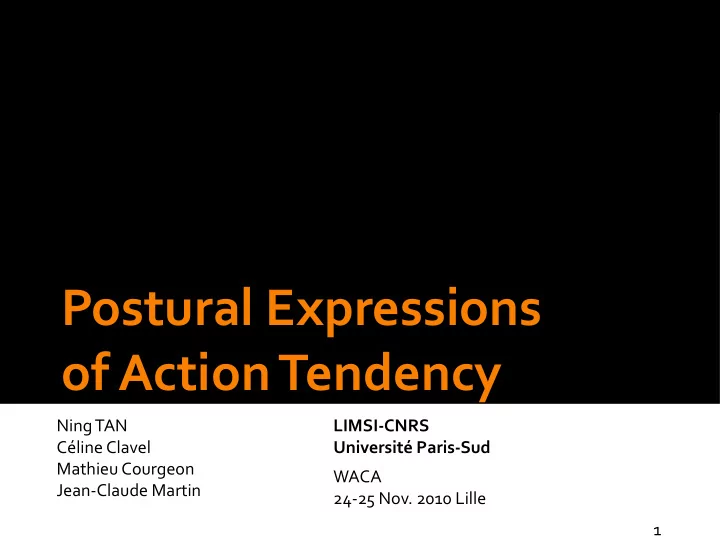

Postural Expressions of Action Tendency Ning TAN LIMSI-CNRS Céline Clavel Université Paris-Sud Mathieu Courgeon WACA Jean-Claude Martin 24-25 Nov. 2010 Lille 1
Plan 1. Introduction 2. Objectifs 3. Stimuli design 4. Test de perception 5. Conclusion 2
Plan 1. Introduction 2. Objectifs 3. Stimuli design 4. Test de perception 5. Conclusion 3
Defnition Action Tendency states of readiness to achieve or maintain a given kind of relationship with the environment. (Frijda et al. 1987) perceivable structure that is intended to indicate an implicit quality about the people or their environment (Frijda et al. 1987) 4
Plan 1. Introduction 2. Objectifs 3. Stimuli 4. Perception test 5. Conclusion 5
Research goals to explore whether postural expressions may convey discriminative and reliable features of action tendencies § to consider the perception of postures in social scenes featuring multiple characters. § to extend the posture library of our MARC platform with postural expressions of 6
Plan 1. Introduction 2. Objectifs 3. Stimuli design 4. Perception test 5. Conclusion 7
Process to design postures of action tendencies annotations design specifcations 8
Corpus of Postural Expressions of Action Tendencies 14 video clips selected from our corpus (PERMUTATION Clavel et al. 2009) with annotations in terms of § action tendencies ▪ Disappear from view, antagonistic, attending, exuberant, in command (Frijda et al. 1989) § postures ▪ head, shoulder, trunk and arm (Bull 1987; Kipp et al. 9 2007; Tan et al. 2010)
MARC Platform MARC (Multimodal Afective and Reactive Characters) is the platform that we develop for conducting experimental studies using interactive virtual characters (Courgeon et al. 2009). 10
Stimuli (1) Static pictures 2 postures per action tendency Action tendency Exuberant labels (Frijda et al. J’ai envie de faire pleins de choses! 1989; Tcherkassof J’ai envie de sauter! 1996) 11 11
Stimuli (2) Attending Disappear from view J’essaie d'observer . J’ai envie de me cacher … J’ai envie de bien comprendre. J’ai envie d'être ailleurs . 12
Stimuli (3) In command Antagonistic Je me sent supérieur aux autres. J’ai envie de m’opposer! J’ai la situation bien en main ! J’ai envie de m'insurger ! 13
Plan 1. Introduction 2. Objectifs 3. Stimuli design 4. Perception test 5. Conclusion 14
Participants 20 subjects: 7 female, 13 male, aged 21-60; 79% European, 16% African, and 5% Asian. We investigate: 1) whether subjects recognized the two target postures that we designed for each action tendencies; 2) how they attributed emotion categories to 15 the 12 postures (whether consistent with the
Procedure Step 1: Action Tendency Recognition For each action tendency, we showed § a short description § 2 target images § i.e. the action tendency specifed in the written description § 4 distracting images § randomly selected out of the other 10 postures Subjects were instructed to choose one OR 16
Procedure Step 1: Action Tendency Recognition Voici diferentes photographies où sont presents deux personnages. Celui que vous voyez de face correspond à l’agent Mary, elle a un tee- shirt et les cheveux bruns. Regardez bien les photographies suivantes et selectionnez une ou X deux photos en mettant une croix sous la ou les photographie(s) caracterisant le mieux Mary quand elle X aimerait disparaitre, se 17
Procedure Step 1: Action Tendency Recognition Distracters Target Target Action (other posture posture Total postures than tendency #1 #2 targets) Attending 52% 10% 38% 100% Disappear from 67% 33% 0% 100% view Exuberant 54% 21% 25% 100% In Command 25% 6% 69% 100% Antagonistic 39% 27% 33% 100% 18
Procedure Step 2: Emotion Attribution Subjects assigned one emotional label to each of the 12 postures: Sadness, Joy, Anger, Anxiety, Surprise, Fear, Irritation, Shame, Contempt, Guilt, Disgust, Pleasure, Despair, Pride (Frijda et al. 1989) Selon vous, quelle émotion l’agent Mary va-t- elle éprouver dans cette situation? Mettez une croix dans la case correspondant à l’émotion qui vous parait la plus probable. X 19
Results Step 2: Emotion Attribution Action tendency Attributed emotions in our Predicted emotions in Frijda et al. study 1989 disappear from view shame, guilt shame exuberant joy, pride, pleasure Challenged, enthusiame, relief, pride, joy, happy, in love antagonistic irritation, contempt, anger, Contempt, annoyance, anger, anxiety rage attending anxiety, anger, irritation Anxiety, startled, jealousy, disappointment, annoyance, distrust, enthusiam, happy, surprise, in love, fascinated, moved in command Contradictory results 22 predicted emotion categories 20
Plan 1. Introduction 2. Objectifs 3. Stimuli design 4. Perception test 5. Conclusion 21
Conclusion Postures of three action tendencies ( Attending, § Disappear from view, Exuberant ) received a high recognition rate, The emotional attribution is quite consistent § across the two target postures for each emotion excepted In command , The action tendency for which the error rate is § the highest ( in command ) corresponds to postures for which subjects attributed few and diferent emotions categories. 22
Conclusion The results suggest that postures expressed in a social interaction scene may provide information about action tendencies in virtual characters. Future directions dynamic features of action tendency § a library of dynamic postures collected with § motion capture 23
Recommend
More recommend